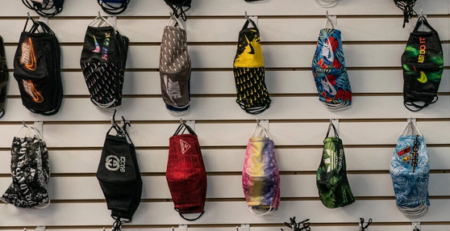New mask ratings, pharmacists find more vaccine, Georgia’s hospitals fill, and more
18 Dec 2020
Posted by Andrew Kantor
ICYMI: Clever pharmacists
Pharmacists are smart people. Smart enough to realize that the vials of Covid-19 vaccines from Pfizer often contained extra vaccine. How much? Enough to potentially increase the supply by 40 percent.
Pfizer didn’t have guidelines. The federal government didn’t have guidelines. So it was up to individual institutions to decide if the extra doses were kosher. (The feds have since given the thumbs-up.
Said, Obama administration acting CMS chief Andy Slavitt, “I think this is more clever pharmacists than something missed by Pfizer.”
Speaking of Pfizer…
…we got to move these Covid vaccines
Pfizer would like someone to tell it where to ship millions of doses of its Covid-19 vaccine that are sitting in a warehouse, “because the company has not received shipping instructions from the federal government.”
It also said that no, despite what you may have heard, it’s not experiencing any “manufacturing challenges” or “hiccups.”
Make ’em smile (or grimace)
If you want to make an injection hurt less there are two things you can do. (If you read the headline, you probably have an idea.) One is to smile sincerely*. The other is, oddly, to grimace.
Both expressions create crow’s feet around the eyes, lift the cheeks, and bare the teeth, and “can also significantly blunt the stressful, needle-related physiological response by lowering the heart rate.”

Wrong Grimace
To be clear, the person getting the injection has to do this, not the person giving it.
* Did you know a real smile is called a Duchenne smile? Me either.
Records
Another day, another record number of Covid-10 cases in the U.S. And yes, we’ve now had more deaths from Covid than from the entire Second World War.
Record hospitalizations in Georgia. “The total reached 3,221 — surpassing the previous peak, 3,200, set in July — according to state Department of Public Health figures released Wednesday.”
Today’s odd little Covid tidbit
The more UV light that day, the less the virus seems to spread. It’s not a huge difference, but it’s noticeable … well, to Harvard scientists.
What does it mean? “These findings suggest that the incidence of COVID-19 may have a seasonal pattern, spreading faster in the winter when it’s darker than in the summer.”
Free Education and Resources on Monoclonal Antibody Treatments for COVID-19
If you woke up today and thought, “I need to know more about the monoclonal antibody treatments being used in long-term care and nursing facilities, you’re in luck.
The American Society for Clinical Pathology is working with HHS to deploy Regeneron’s antibody products. It’s offering a free webinar on the treatment this Thursday at 10:00am EST and again at 3:00pm Eastern.
Free yes, but you need to register for the webcast Packaging and preparation of casirivimab and imdevimab
Want to know more about the packaging and preparation of casirivimab and imdevimab? Click right here.
How safe was that masked man?
So you know N95 masks, right? They’ve got that official NIOSH “N95” rating. But the masks we’re seeing for Covid protection, well… you don’t know what you’re gonna get.
Not for long. (Probably.) NIOSH and ASTM International are in the process of writing guidelines for masks beyond N95 (and its oft-counterfitted Chinese counterpart, KN95). Hopefully that will mean you can choose your fashionable mask for Covid-21 with a bit more confidence.

Masks are the new power ties
Special delivery (to tumors)
So mesenchymal stem cells (MSCs) are good at finding tumors. But if you try to get them to carry drugs, like asking a teenager to take out the trash, they get cranky and confused.
Japanese researchers were not taking that sitting down. They found a way to get “liposomes-cellular lipid bags” to attach to the stem cells, bypassing the cells’ crankiness and allowing them to deliver doxorubicin to cancer cells in mice.
“We have succeeded in developing a new targeted cancer therapy. Mesenchymal stem cells can migrate to brain tumors and minute cancer lesions that are otherwise inaccessible to conventional drug delivery systems.”
The long read: The more things change
“What the Pandemic Christmas of 1918 Looked Like”


